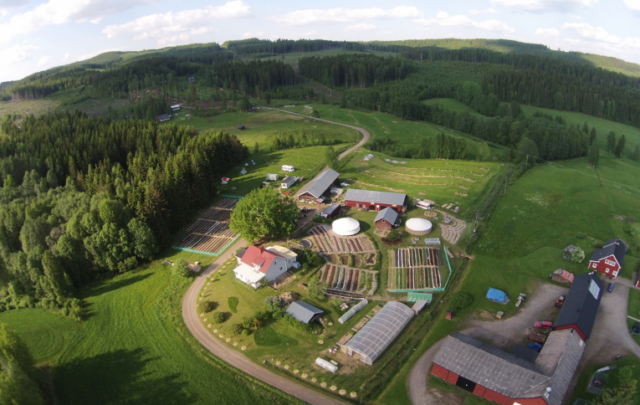 The Transition Handbook
The Transition Handbook
From oil dependency to local resilience
Rob Hopkins
Green Books 2008 Paperback
240pp
Available at Transition Culture
“The concept of energy descent, and of the Transition approach, is a simple one: that the future with less oil could be preferable to the present, but only if sufficient creativity and imagination are applied early enough in the design of this transition.”
-Rob Hopkins, The Transition handbook
The publication of the much anticipated Transition Handbook marks the latest landmark in what has become the fastest growing environmental movement since CND in the 1960s: the phenomenon that is sweeping the UK, the Transition Towns movement.
The book is clearly written and entertainingly illustrated- including some original line drawings by the author. Primarily it is a handbook for inspiring and guiding communities into a new sustainable future with less dependency on fossil fuels. Comparisms with the recent early-industrial past- food production and allotments during Britain’s “wartime mobilisation” in the 1940s for example- make fascinating reading and give some kind of pointers for how large-scale change could happen again- if we only had the collective will and sense of urgency to achieve it.
What makes it unique is that this is not merely aspirational, but also documents the meteoric rise of the transition movement. Its advice and exercises have been hewn on the workbench of real local communities making the first steps of a radical transformation that the whole of the developed world will have to confront over the coming years.
 Placed through the book are 12 “Tools for Transition” describing in detail different workshop activities that can be used to help develop a process and facilitate discussions, including “Open Space” and “World Café”; the “web-of-life” game is described, but has become the “web of resilience”- a game whereby participants stand in a circle and pass a string back and forth between them representing links between different elements of a woodland or a community:
Placed through the book are 12 “Tools for Transition” describing in detail different workshop activities that can be used to help develop a process and facilitate discussions, including “Open Space” and “World Café”; the “web-of-life” game is described, but has become the “web of resilience”- a game whereby participants stand in a circle and pass a string back and forth between them representing links between different elements of a woodland or a community:
“it is becoming clear that the cheap oil required to sustain our oil-dependent lifestyles is not going to be with us indefinitely, we find ourselves looking around at the severed strands of web and starting to wonder which strands might reconnect to which others. The Transition approach is one of re-weaving this web, and remaking the connections which will be needed by a resilient post-oil economy. Every new harmonious relationship we forge is a step back to sanity.”
It all started at the end of the summer of 2004 when Rob was teaching permaculture in Kinsale, the course he had set up three years earlier- a 2-year Practical Sustainability course, one of the only courses of its kind anywhere in the world. Davie Philip of Cultivate had just shown me The End of Suburbia and I gave a copy to Rob just before the start of term. He immediately arranged to show it to the students along with a talk by Colin Campbell, and presented with them what must still be the greatest challenge to have faced permaculture students on that course: to write an Energy Descent Action Plan for the town of Kinsale.
This daunting task was undertaken with considerable enthusiasm and the document they produced has been hugely influential in framing the tasks ahead for those seeking effective responses to peak oil and Climate change.
The Fuelling the Future conference followed, and then Rob moved to Totnes and I took on his job as permaculture teacher in Kinsale.
 Inspired by the EDAP and keen to see it develop, one of the first projects I undertook was to ask the town council to locate a suitable piece of within the town boundaries which we could do a design for as a potential community garden. Although the first site located was eventually deemed unsuitable, the following year a small plot on a council estate was designed by students and continues to serve as a community garden for the Transition Towns group in Kinsale. Permaculture Students continue to play a major role in developing TTK, organising events, building school gardens, and through their course work, engaging in more design work in the town with a view to creating more gardens.
Inspired by the EDAP and keen to see it develop, one of the first projects I undertook was to ask the town council to locate a suitable piece of within the town boundaries which we could do a design for as a potential community garden. Although the first site located was eventually deemed unsuitable, the following year a small plot on a council estate was designed by students and continues to serve as a community garden for the Transition Towns group in Kinsale. Permaculture Students continue to play a major role in developing TTK, organising events, building school gardens, and through their course work, engaging in more design work in the town with a view to creating more gardens.
In the meantime, across the water a small revolution has been brewing, with Transition initiatives now numbering dozens around the UK- and beyond- and groups that are “mulling” – considering starting a process- now in the hundreds. Somehow, Rob has hit upon an idea, a theme for our times that has captured the imagination and in less than three years shown what power there can be in community.
All this and more is described in the handbook, which is divided into three parts, the “Head, Heart and Hands” of energy descent.
In the first section, Rob outlines the issues of climate change and peak oil but skilfully weaves them together and shows how the two must be considered as two sides of the same coin if we are to make an appropriate response: just cutting carbon emissions, as proposed in some “conventional” programmes for addressing climate change, for example, will never be enough: our dependency on systems that require high energy inputs from fossil fuels may make us even more exposed as we begin to run out. Equally, Rob’s wit and sharpness is put to good effect to expose some of the more absurd- and dangerous proposed solutions to energy depletion. For example, of tar sand he writes:
“Tar sands are akin to arriving at the pub to find that all the beer is off, but so desperate are you for a drink that you begin to fantasize that in the thirty years this pub has been open for business, the equivalent of 5,000 pints have been spilt on this carpet, so you design a process whereby you boil up the carpet in order to extract the beer again.”
The key theme that he introduces early on and builds on throughout the book is the idea of resilience. This is essentially the quality that allows communities to provide most of their essential needs- food, energy, water and raw materials- from multiple sources so that in the event of the large-scale system failures we are faced with collapse is averted because the smaller-scale local community has the wherewithal to fend for itself. This is the quality that has been systematically eroded by the globalization process as small communities have over the last hundred years in the west and much more recently in the developing world- as described for example by Helena Norberg-Hodge in Ladakh- and this is the quality that the Transition process aspires to recreate.
“The move towards more localised energy-efficient and productive living arrangements is not a choice; it is an inevitable direction for humanity… The time for seeing globalisation as an invincible and unassailable behemoth, or localisation as some kind of lifestyle choice, is over.”
The second section, the Heart, deals with some of the defining features of the transition movement which have made it so successful: the insistence that a positive vision of the future is more important to galvanise change than focusing on the various dystopias all-to-common in peak oil literature.
“Environmentalists have often been guilty of presenting people with a mental image of the world’s least desirable holiday destination – some seedy bed and breakfast near Torquay, with nylon sheets, cold tea and soggy toast – and expecting them to get excited about the prospect of NOT going there. The logic and the psychology are all wrong.”
Rob admits,” I am aware that being one of those people who can read a desperately depressing book about peak oil and societal collapse and draw from it the inspiration and motivation to do something practical puts me in an extremely small minority.”
This is perhaps the most original contribution of the transition project, looking at the psychology of change and integrating an understanding of what motivates people and what can hold them back into an understanding of the environmental crisis we are dealing with.
The two main ways this is looked at are addiction therapy and community visioning. The first is covered by an interview with Dr. Chris Johnstone who talks about the Stages of Change model and how it can be applied to kicking the oil habit.
The idea that we are “addicted to oil” is a controversial one; nevertheless, these tools may have a significant role to play in helping us to understand the grip that a consumer lifestyle has on people, and addressing the obstacles to change like fear that may come up. I think it is essential for the environmental movement to begin to take seriously the psychology of change and ask more often “why don’t more people appear to care about sustainability?” There is a huge amount of work still to be done in this area- it would have been nice to see for example some references to what evolutionary psychology can contribute- but this is a handbook and we are given some useful practical tools to get started.
The section on visioning describes the process of scenario planning where people are asked to envisage a post-peak future in which the community has successfully achieved the transition to a low-energy, sustainable and localized state – and then come up with imagined newspaper stories in the future- some of which are reproduced in the book and make hilarious reading- check out the Beckham’s cob retirement home from 2029!
By way of getting us to think about things in a different way, Rob also invites us to question whether “Peak” oil is really the best word to use:
“The idea of energy descent is that each step back down the hill could be a step towards sanity, towards place and towards wholeness. It is a coming back to who we really are, similar to how members of a busy family rediscover each other during a power cut. Energy descent is, ultimately, about energy ascent – the re-energising of communities and culture – and is the key to our realistically embracing the possibilities of our situation rather than being overwhelmed by their challenges.”
The final section is “The Hands” in which Rob takes us through the transition concept- including a look at some of its inspiration such as Holmgren’s Permaculture Principles– and how it fills a gap between the “light-bulb syndrome” of useful but wholly inadequate individual changes, and government actions on the national scale:
“The transition model explores the ground between these two: what could be achieved at a community level”.
It is significant I think that Rob includes a table showing the difference between this permaculture-informed community response and conventional environmentalism which has often only had piecemeal solutions which address the symptoms, not the cause. One of these is the emphases not only on carbon footprints, but on the need to build resilience in every facet of a community.
The following chapters cover How to Start a Transition Initiative, including the 12 steps of transition; an account of the first year of Transition Town Totnes, the most interesting project initiated there being the Totnes pound, a local cash currency that has generated huge media interest in the Transition Movement; and how the process went viral and spread in a matter of months to hundreds of communities across England, Wales and Scotland, with stories of how the process has developed in some of these pioneering places.
The emphasis of the book is primarily on community processes and in this it is an excellent and inspiring resource. This is important also because the first steps of any such process is the enrollment of the local community into the idea of preparing for the inevitable changes ahead.
It would have been good also to see perhaps an extra appendix on, for example, the basics of energy and how to conduct a simple domestic energy audit;. more detail on the assessment of needs in terms of per capita energy use, amount of land available, amount of land required per capita to grow food; approximations of land needed to grow bio-fuels for on-farm use; population trends; etc..
This is the area now ripe for moving into with Energy descent Planning- counting, calculating, assessing. There is a lot of work to be done, much of it technical and requiring specialist skills and as such perhaps beyond the remit of the transition handbook. What Rob does do is lay the important groundwork and show how to go about finding those within the community who have the necessary skills.
Reading through the handbook and reflecting on the process as I have observed it blossoming under Rob’s gentle guidance over the last couple of years, I got the impression that the future was already here, that somehow all the things we all want to see in our communities- the cycle lanes, the school gardens, the walnut tree plantations and the solar panels- that these features of a sustainable society really can be here because there is just no reason not to have them. To get there will take tremendous effort, but if the apocalyptic visions of petrol riots, food shortages and flooded coastal cities are the stick, the Transition Handbook is surely the carrot we need to lure us on.
“While peak oil and climate change are undeniably profoundly challenging, also inherent within them is the potential for an economic, cultural and social renaissance the likes of which we have never seen. We will see a flourishing of local businesses, local skills and solutions, and a flowering of ingenuity and creativity. It is a Transition in which we will inevitably grow, and in which our evolution is a precondition for progress.”
Bring it on.





